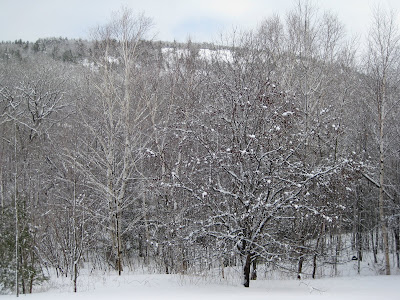After several nights of sleeping poorly, this morning I was finally able to sleep in. At least until my cat, apparently alarmed that I was not following my usual morning ritual, jumped up on the bed and meowed repeatedly. When that didn't get me up, she then began attacking things on my nightstand. I put a stop to that with a pillow, and she eventually settled in to do what cats do best: sleep.
But just as I was beginning to blissfully drift back into gentle slumber myself, a crow started up outside the bedroom window with a low, gutteral "caw, caw, caw," repeated about ten times. Then another came flying in, cawing on a slightly different pitch. Then there were three. Three crows can make a real racket. I could hear the jays joining in, too, so I figured there must be something out there upsetting them, like a hawk or owl or cat. So then I had to get up. Some people need black coffee to wake them up, I just need a flock of loud black birds. Out the window, I couldn't pick out anything among the tangle of branches but the silhouettes of crows and jays, and a pair of squirrels chasing each other around a tree trunk. Were the corvids morally offended by the squirrels' amorous frivolity? When one crow settled onto the neighbor's lawn to aimlessly poke around in the grass, I figured whatever had stirred them up couldn't be
that important. But it had gotten me out of bed, at least.
As I type, they're back, one in the same tree as before, renewing their cawing brigade up and down the river's foamy path. Now six or seven crows have flashed into view above the water, all diving at something. With that level of activity, I'd expect to see an eagle, at least, but I think it might be all about food. They seem to be chasing one of their own, who has either found something edible or committed a crow transgression.
And now the plot thickens--a black-and-white cat that I've never seen before just emerged from behind our shed. Was it a cat after all? But the crows ignore the cat, occupied by something upriver. Who can fathom the mysteries of what goes on in a crow's mind? A perfect bird nerd activity for me would be to spend the whole day in my backyard Twittering about the crows' activities.
Counting crows this morning has reminded me of the traditional fortune-telling poem. This is how I learned it:
One for sorrow, two for mirth,
three for a wedding, four for a birth,
five for silver, six for gold,
seven for a secret never to be told.
But I just Googled it and found a longer version:
One for sorrow, two for joy,
three for a girl, four for a boy,
five for silver, six for gold,
seven for a secret never to be told,
eight for a wish, nine for a kiss,
ten for a time of joyous bliss.
However many crows are out there right now, they're certainly harboring a secret that they'll never tell me, at least until I learn to speak Crow. You never really know what they're up to.
Awakened by crows,
I ponder their dark secrets,
their strange augury.





















